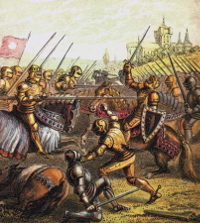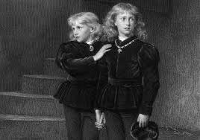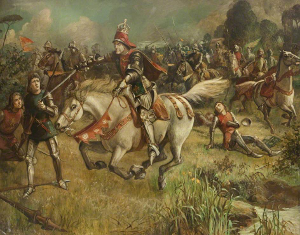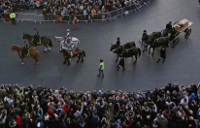King Richard III of England
King Richard III was the ruler of England for two years at the end of the civil war known as the Wars of the Roses. He has been described in two opposite ways down through the years, and his legacy is a complicated one. Richard was born at Fotheringay Castle on Oct. 2, 1452. He was the 11th child of Richard, Duke of York and Cecily Neville. Three years later, York led a large number of soldiers against followers of the House of Lancaster, represented by King Henry VI, in the Wars of the Roses. 
Richard and his older brother George were among those who fled England in 1459, when the Lancastrians gained the upper hand in the conflict. The young boys went further afield the following year, when their father and an older brother, Edmund, died at the Battle of Wakefield. In the meantime, their older brother Edward had taken on their father's mantle and led the Yorkist forces into battle. Richard and George lived in the Low Countries for a time and then came back to England once Edward had won a smashing victory at the Battle of Towton. The coronation of King Edward IV took place on June 28, 1461, and Richard took part. He was then named Duke of Gloucester. Richard was still just 9 at this point and so spent a few years at Middleham Castle in Wensleydale, in Yorkshire, studying under his cousin, the Earl of Warwick, Edward's strongest supporter. Among Richard's training was the arts of knighthood and war. Richard and Warwick were on opposite sides of the latter's revolt against King Edward in 1469; Warwick's changing sides and aiding Queen Margaret, wife of the deposed King Henry VI, and the Lancastrian forces was enough to turn the tide of the conflict for a time, and Richard fled the country again, this time going to Burgundy, along with Edward. 
Edward and Richard returned to England, and Richard, then 18, contributed to his brother's victories at the Battle of Barnet and the Battle of Tewksbury; at the latter, Richard particularly distinguished himself and played a key part in his brother's victory, when defeat looked imminent for a time. Not long afterward, Richard married Anne Neville, a daughter of the Earl of Warwick. Richard's family had other marriage plans for him, but he chose Anne. He so wanted his brother George to approve the match that he relinquished control of most of the property that Warwick had given him through the years. George quarreled repeatedly with his brothers in the next few years. Richard and Anne had a son, Edward, in 1473. Richard gained the rights to other lands and was named Constable of England and then Lord High Admiral. He was highly regarded in the north of England, particularly in York, and had many responsibilities in that part of the country. Edward sent Richard further north a few years later, and Richard oversaw England's response to war once again with Scotland. Richard had immediate success, including the recapture of the town of Berwick, and Scotland soon sued for peace. King Edward IV died on April 9, 1483, and named his 12-year-old son, Edward, as his successor and Richard as Lord Protector of the Realm. Acting on the king's behalf, Richard set about dealing with plots to rob the young king-to-be of his throne. The first to be accused was William Hastings, who was thought to have been an ally of Edward and Richard but had been accused of plotting the young heir's overthrow. The next challenge to young Edward's ascension to the throne was testimony given by a clergyman that Edward IV's marriage to his wife, Elizabeth Woodville, was invalid because he had been married before, secretly, and not given permission to marry again by the Church; if true, that would mean that his sons were not legitimate heirs to the throne. This information became public just a week before Edward's planned coronation. 
England had a long history of instability in the wake of problems with succession, and a large number of people in London, nobles and commons alike, signed a petition that urged Richard to take the throne. He agreed to do so and was crowned on July 6, 1483. Young Edward, who would have been King Edward V, did not attend the coronation; neither did his young brother, Richard. Both boys were in the Tower of London, which at that time wasn't solely a notorious prison but had some parts of it apportioned for visiting dignitaries. Richard and Queen Anne, accompanied by their young son, left London a few days later in order to make a tour of the country. They made grants to the church and to King's College and Queens' College, and Richard founded the College of Arms. King Edward IV's two young sons were seen for the last time the following month, standing at a window in the Tower. They were never seen or heard from again. While Richard was enjoying his kingship in York, in which he already had a large amount of support, the Duke of Buckingham rebelled, counting on the support of Henry Tudor, whose father was Edmund Tudor, whose mother had been the wife of King Henry V. Richard, at the head of an army, made quick work of Buckingham's forces and captured Buckingham himself, later executing him for treason. Henry Tudor proved ineffective in providing support because a storm disrupted his reinforcement efforts, and he fled to France, where he secured support for another invasion. Tudor announced on Christmas Day 1483 that he was the rightful King of England. An act of Parliament in 1484 declared Richard the lawful king and his son, Edward, the lawful successor. Young Edward died on April 9. Richard suffered further tragedy in 1485, when his wife died. That was in March. In July, Henry Tudor, again pressing his claim as the rightful ruler of the realm, returned to Wales and had a large army behind him. Richard summoned a large force and rode westward to confront Henry and his army. 
The two sides clashed on Aug. 22, 1485, at the Battle of Bosworth Field. At a key moment in the battle, one of Richard's key supporters, Lord Stanley, switched sides and began attacking what had been at the start of the day their allies and another key supporter, Henry Percy, refused to obey orders and commit his contingent of troops to the fray. The royal army had begun the day with forces outnumbering Henry's. That changed. Richard decided that his only real chance to win the battle was to eliminate his opponent, so he led a cavalry charge deep into the Tudor ranks. An experienced soldier and feared battle commander, Richard killed Tudor's standard-bearer and was very close to killing Tudor himself but was kept from doing so by a number of Lord Stanley's men. Richard died a particularly violent death and was the last King of England to die in battle. Henry, despite playing little part in the proceedings, was free to claim the throne, which he did. He was named King Henry VII.
After Richard's death, his opponents began to mention stories of how Richard was responsible for the death of the princes in the Tower. Henry Tudor had no problem fanning these flames of posthumous resentment. Richard's body was party to particularly violent abuse after his death as well, and he remained for hundreds of years the only English king without a tomb. Archaeologists in 2012 discovered a body underneath a parking lot in Leicester. Initial tests of what was left of the skeleton found wounds consistent with contemporaneous descriptions of Richard's death blows. DNA testing in 2013 confirmed that the remains were indeed Richard III. His remains were reinterred at Leicester Cathedral in 2015. |
|
Social Studies for Kids
copyright 2002–2025
David White





